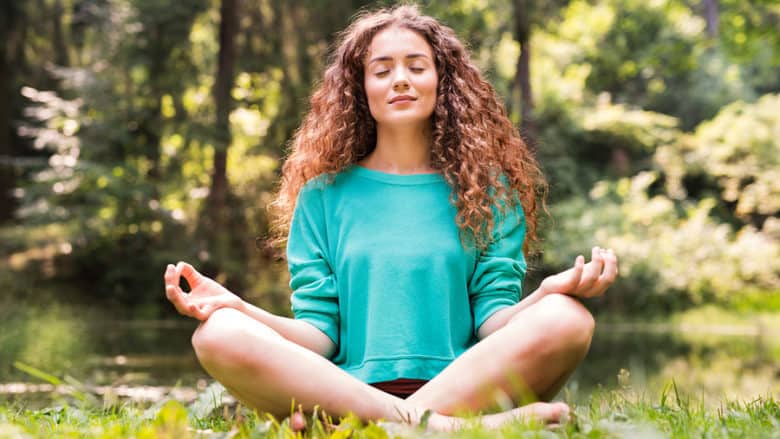
Meditation tips help you create the conditions for meditation. Create the conditions for meditation and meditation will happen:
Imagine your mind as a candle flame that is fanned by the nature of your thoughts and emotions. When your thoughts and emotions are agitated the flame flickers, swirls, and constantly changes.
The flame will burn steady only when you can calm the air around it; when you still the turbulence of your thoughts and emotions. To calm this turbulence, it helps to create an environment that brings peace to the mind, that inspires the mind.
Here are some proven meditation tips to enrich your environment.
9 Meditation Tips
- Create a nurturing, inspiring meditation place and space.Choose a place that feels “good” to you. Fill it with items that inspire you:
- A spiritual picture or statue, a crystal, or other items that have personal meaning
- A shaw for your shoulders and small blanket for your lap to use if you get cool
- A pillow to place beneath your feet
- A candle or incense
- A view of nature
Once well practiced, you will be able to meditate anywhere.
- Set aside time just for you
Choose a time that is right for you, a time that you are least likely to be disturbed. Let others know not to disturb you.You may want to start with only 2 minutes. You can increase this time when you feel ready. Set a goal for at least 30 minutes once or twice a day. - Get comfortable
Loosen or remove belts or restrictive clothing. Take off your shoes. - Sit in an inspired posture
- Sit on a straight back chair with both feet on a pillow on the floor, or with your legs crossed on a pillow or chair in a lotus (yoga) or modified lotus position. The proper alignment of the body is very important especially the spine.
- Take a deep breath, imagine the breath inspiring you, settle in.
- Keep your back straight (relaxed-not stiff), shoulders back, and head balanced on your neck as though hanging from a string from the sky with your chin slightly tucked in. (Unless it is a moving meditation such as Yoga or Tai Chi.)
- Place your hands on your lap one resting on the other just below the navel or place one on each thigh.
- It’s generally recommended not to lie down as it is too easy to fall asleep.
- If you start to feel uncomfortable, gently reposition yourself.
- Open your mouth slightly as if saying a relaxed Aaaah
Allow the tip of the tongue to rest lightly against the roof of the mouth behind the teeth. With your mouth slightly open, jaws relax naturally. It also is said in the Tibetan meditation tradition that a slightly open mouth decreases the karmic winds. - Eyes may be open or closed
Although most meditation techniques are done with eyes closed, others leave them open so that it is easier to carry the meditative state into everyday life.When meditating with eyes open, the gaze is soft focused. It is like a child’s gaze that takes everything in without specific focus. Or, the eyes may be focused on a specific object like a candle or mandala. - Interruptions happen, even with the best preparation
The phone may ring; you may hear noises you didn’t notice before. Let the phone ring, let the noise be noise and focus on your meditation.Passively, let the disturbing or intrusive sounds or thoughts go. Some imagine them as bubbles floating away or a river passing by. - Be gentle with yourself
Develop an attitude of acceptance when your mind wanders, or you feel restless, gently returning to your meditation by focusing on your breath.Most people are surprised when they first start meditating by how unruly their mind is. As they meditate they start thinking about what to prepare for dinner, or their “to do” list, or an argument they had, or how good their doing at meditation.These thoughts are treated as “just thoughts.” They are not good. They are not bad. Once noticed, gently bring your focus back to your meditation. - When finished, sit quietly a few minutes and reflect on your meditation
Take a deep breath and savor the effects of meditation. You may feel peace, gratitude, or nothing at all. You may feel frustrated because your mind wandered.There is a Tibetan saying: “It’s a tall order to ask for meat without bones, and tea without leaves.” As long as you have a mind, you will have thoughts and emotions, says Sogyal Rinpoche in The Tibetan Book of Living and Dying. Sometimes meditation comes easy, sometimes it doesn’t. What’s important is beginning and continuing the practice. It all counts.
Feel free to modify these meditation tips based on your own experience.
Once you develop stability in your meditation practice, disturbances of every kind, in all aspects of your life, will have far less impact.
Key Points
Meditation supports natural healing, it trains your mind to let go of troubling thoughts and emotions. It reconnects you with your true nature, your essence, who you really are.
With meditation, there is no competition where one’s practice is better than another. Where ever you are is where you are. All that matters is that you begin.
Use these meditation tips to enrich your meditation journey.
